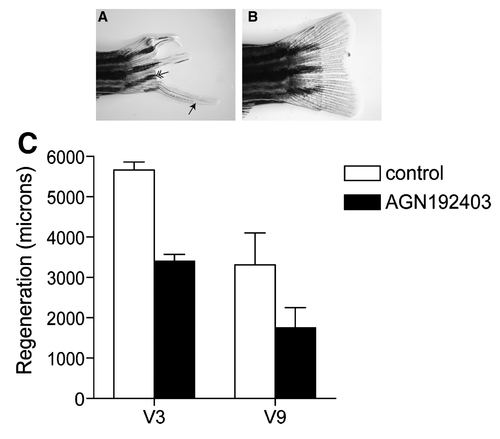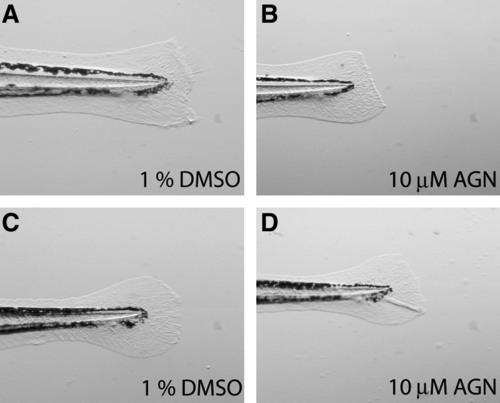- Title
-
A Chemical Screen to Identify Novel Inhibitors of Fin Regeneration in Zebrafish
- Authors
- Oppedal, D., and Goldsmith, M.I.
- Source
- Full text @ Zebrafish
|
Inhibition of fin regeneration by budesonide and AGN192403. Results from treating fish with 10 μM AGN192403, 10 μM budesonide, or 1% dimethyl sulfoxide (DMSO) in the primary screen. Fin regeneration is inhibited by AGN192403 (A, B) and budesonide (D, E) when compared to DMSO controls (C and F, respectively). |
|
AGN192403 targets the imidazoline receptor. (A) Zebrafish fins were amputated at approximately the level of the first fin ray bifurcation. Fish were treated with 50 μM clonidine, 50 μM Idazoxan, or 1% DMSO (control). Regeneration was allowed to proceed for 72h postamputation (hpa) at 33°C. At 72 hpa, the length of fin ray regeneration (microns) was measured. For all measurements we used the third dorsal fin ray and measured from the original amputation plane to the distal tip of the regenerating fin. Data represent means ± standard error of the mean (SEM). n = 10 for each group. (B) Qualitative RT-polymerase chain reaction for the zebrafish NISCH gene. cDNA was prepared from 72 hpa fin regenerates and used as template to amplify the zebrafish NISCH gene. A 600–700 bp NISCH band is strongly amplified from regenerating caudal fin (arrow, lane 2). No amplification of NISCH is seen in controls lacking primer (lane 3) or cDNA template (lane 4). Lane 1 contains 100 bp ladder. EXPRESSION / LABELING:
|
|
AGN192403 blocks cell proliferation. (A, B) Bromodeoxyuridine (BrdU) staining of frozen sections from 72 hpa fin regenerates. Fish were treated with 1% DMSO (A) or 25 μM AGN192403 (B) from 12 to 72 hpa. BrdU-labeled cells were counted if they were deep to the basement membrane (yellow lines) and within 1000 μm of the distal tip of the fin (white lines). (C) AGN192403 significantly decreased the number of BrdU-labeled cells compared to control treated fins (n = 5 fins per group, 20 sections per slide; data represent means ± SEM). |
|
AGN192403 inhibits fin regeneration at multiple stages. (A, B) AGN192403 inhibits msx-b expression in the regenerating fin ray blastema. Whole-mount in situ hybridization demonstrates a dramatic reduction in msx-b transcript (arrows) in AGN192403-treated fish (A) compared with controls (B). (C) AGN192403 inhibits the outgrowth stage of fin regeneration. After fin amputation, zebrafish were treated with AGN192403 (or DMSO [open squares]) either from days 2–7 (open triangles) or days 7–12 (open circles) postamputation. Regeneration was inhibited regardless of whether AGN192403 was added during the early (days 2–7) or late (days 5–12) stages of outgrowth. EXPRESSION / LABELING:
|
|
AGN192403 can permanently inhibit regeneration of some fin rays. (A) Fish were treated with AGN192403 for 7 days after fin amputation. Compound was then removed and regeneration was allowed to proceed for 30 days (25°C). Regeneration proceeded normally in some rays (arrow) but was completely absent in others (double arrow). (B) When these same fins were reamputated proximal to the original amputation plane, regeneration proceeded normally. (C) After fin amputation and 7 days of AGN192403 or DMSO treatment, fish were recovered for 2 weeks in fresh water (no drug) and the degree of fin regeneration was quantified for the longest (V3) and shortest (V9) fin rays. AGN192403-treated fish failed to completely restore their fins. These data were significant for both V3 and V9 (p < 0.05) (data represent means ± SEM). |
|
AGN192403 inhibits fin fold regeneration. Larval fin folds were amputated (A, B) and then allowed to regenerate for 3 days (28.5°C) (C, D). (A, C) 1% DMSO alone had no effect on fin fold regeneration. (B, D) An example of inhibition of larval fin fold regeneration when larvae are treated with 10 μM AGN192403 following amputation of the fin fold. |






